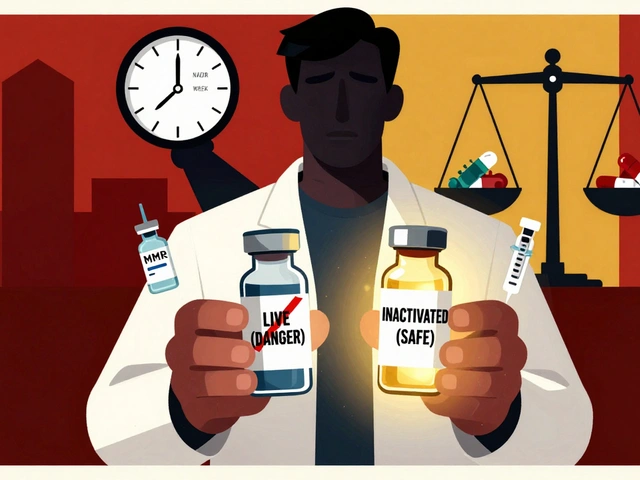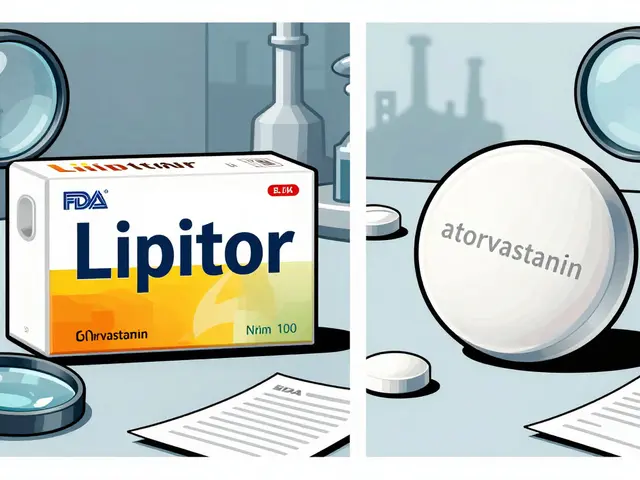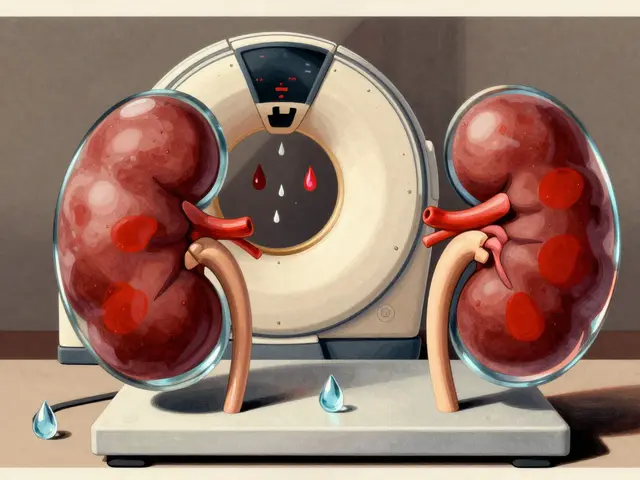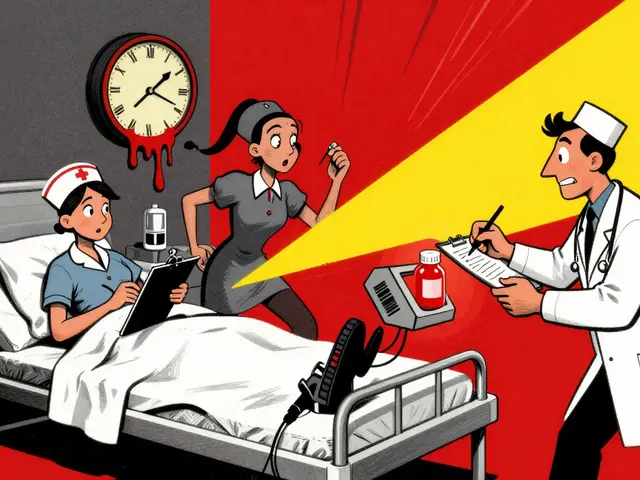Traveling abroad with prescription meds isn’t just about packing your bottle. It’s about making sure the pharmacy in Tokyo, Paris, or Dubai can read it-and give you the right pills. A lot of people assume Google Translate will do the job. It won’t. Misreading a dosage or confusing a brand name can land you in the ER. I’ve seen it happen: a traveler in Berlin got the wrong strength of blood pressure pills because the label said "10 mg" but the pharmacist thought it was "100 mg". That’s not a typo. That’s a translation failure.
Why Medication Names Vary by Country
The same drug can have five different names depending on where you are. Take ibuprofen. In the U.S., you buy it as Advil or Motrin. In France, it’s Ibuprofène. In Poland, it’s Abfen. In Australia, it’s just ibuprofen on the box. The active ingredient is identical, but the brand name? Totally different. That’s why you can’t just show a pharmacist your American bottle and expect them to hand you the same thing. Even worse, some names sound almost the same but are completely different drugs. Ambyen (used for heart rhythm issues in the UK) and Ambien (a sleep aid in the U.S.) look nearly identical. Mix them up? You could end up sedated when you need your heart stabilized. The World Health Organization created the International Nonproprietary Name (INN) system to fix this-ibuprofen, metformin, lisinopril are the global generic names. But pharmacies still use local brand names. If you don’t know the INN, you’re flying blind.Dosage Confusion Is a Silent Killer
Dosage formats vary wildly. In the U.S., pills are often labeled in milligrams (mg). In some countries, they use grams (g), micrograms (mcg), or even units (U). A prescription that says "1g" could mean 1 gram (1000 mg) or 1 milligram, depending on how it’s written. One Reddit user shared how a Spanish prescription for "1g" was misread as 1 gram instead of 1000 mg. The patient thought they were getting a weaker dose. They weren’t. They were getting the full dose-but thought they were underdosing. That’s the kind of mistake that leads to overdoses or treatment failure. Pills also come in different shapes and sizes. A 500 mg tablet in the U.S. might look like a tiny white pill. In Mexico, the same strength could be a large, colored capsule. If you don’t know what the real pill looks like, you might refuse to take it because it doesn’t match your memory. Pharmacists abroad don’t always know your original brand. They need the active ingredient and the exact dose.What You Need to Bring Before You Travel
Don’t wait until you’re out of pills in a foreign city. Here’s what to pack:- Your original prescription-with the doctor’s signature and pharmacy stamp.
- A written list of every medication: generic name, brand name, strength, dosage (e.g., "Ibuprofen 400 mg, take one tablet twice daily"), and purpose (e.g., "for arthritis pain").
- Physical copies of pill bottles-take photos of the label, too. Include the manufacturer and lot number if possible.
- The INN-look up your drug’s international generic name on the WHO website or Drugs.com. Write it down.
- A letter from your doctor explaining why you need the meds. This helps if customs asks questions.

How Foreign Pharmacies Actually Translate Prescriptions
Most large pharmacies in tourist-heavy cities-Dubai, Bangkok, London, Berlin-have staff trained in basic medication translation. But don’t assume they know your language. Instead, give them your written list and ask: "Can you match this to your local version?" Professional pharmacy translation services like RxTran and Stepes use databases that link over 150 country-specific brand names to their INN equivalents. These systems don’t just translate words-they cross-reference active ingredients, dosages, and regulatory rules. For example, if you have a U.S. prescription for "Lisinopril 20 mg", their system knows that in Italy it’s "Lisinopril Sandoz 20 mg", in Canada it’s "Zestril 20 mg", and in Japan it’s "リシノプリル 20 mg". Pharmacies that use these systems can print labels in the local language with warnings like "May cause dizziness" or "Take with food". They also flag interactions. If you’re on warfarin and the local pharmacy tries to give you a cold medicine with pseudoephedrine, their system will alert them. General translation tools like Google Translate can’t do that.Why Google Translate and Apps Fail
Google Translate, DeepL, or even AI chatbots? They’re dangerous here. They don’t understand medical context. Translate "Take one tablet by mouth twice daily" into Spanish? It might come out as "Tome una pastilla por la boca dos veces al día"-which sounds right. But if the original said "Take one tablet of 500 mg by mouth twice daily" and the AI drops the "500 mg", you’re in trouble. A 2022 study of international healthcare providers found that 68% had seen patients given the wrong dose because of poor translation. In one case, a Chinese patient was told to take "0.5 tablet"-but the translator didn’t know that in China, "0.5" meant half a tablet, while in the U.S., it meant 0.5 mg. The patient took the whole tablet and ended up in the hospital. AI tools also don’t know about country-specific regulations. In the U.S., you can buy 200 mg ibuprofen over the counter. In Germany, you need a prescription for anything over 400 mg. A translator that doesn’t know that could give you the wrong advice.What to Do If You Can’t Find Your Medication
Sometimes, your exact brand isn’t available. That’s okay. You don’t need the same box. You need the same active ingredient and dose. Use Drugs.com’s international drug lookup tool. Type in your U.S. brand name-it’ll show you equivalents in over 30 countries. For example:- Advil (U.S.) → Ibuprofène (France), Nurofen (UK), Ibuprom (Poland)
- Lexapro (U.S.) → Escitalopram (global INN), Cipralex (Canada), Seropram (Australia)
- Metformin (U.S.) → Glucophage (global brand), Glucophage XR (extended release)
Regulations You Can’t Ignore
Some countries require translated labels by law. In New York, pharmacies must provide labels in Spanish, Chinese, Russian, and Italian if those are the top languages spoken locally. California is expanding to 15 languages. In the EU, all prescription labels must include the INN and dosage in the local language. If you’re bringing meds into a country, check their customs rules. Some ban common U.S. drugs. For example, the U.S. version of pseudoephedrine (in cold meds) is illegal in Japan and Thailand. Even if it’s for personal use, you can get arrested. Always check the embassy website.When to Use a Professional Translation Service
If you’re on a complex regimen-multiple drugs, high-risk meds like blood thinners, insulin, or epilepsy drugs-don’t gamble. Use a certified medical translation service. RxTran, Stepes, and First Databank offer secure, HIPAA-compliant translation with pharmacist review. They don’t just translate words. They verify dosage math, check for interactions, and confirm regulatory compliance. These services cost money-starting around $3,500 a year for pharmacies-but for travelers, it’s worth it to pay $25 to have your prescription translated before you leave. Some travel insurance companies offer it as a free add-on. Ask.Final Checklist Before You Fly
- ☐ Bring 3x more pills than you think you’ll need
- ☐ Write down the INN for every medication
- ☐ Note the exact dose and frequency (e.g., "5 mg once daily")
- ☐ Carry your original prescription and doctor’s letter
- ☐ Take photos of every pill bottle
- ☐ Know the local name of your drug in your destination country
- ☐ Check if your meds are legal in that country
- ☐ Save a contact for a local pharmacy in your destination
Can I just show my pill bottle to a foreign pharmacist?
No. Brand names vary by country, and pill shapes/colors don’t mean the same thing. A pharmacist in Spain won’t recognize "Advil"-they need to know it’s ibuprofen 400 mg. Always bring the generic name and exact dose written down.
Is it legal to bring my U.S. medications abroad?
Most countries allow personal-use quantities if they’re in original bottles with a prescription. But some ban common U.S. drugs like pseudoephedrine, codeine, or certain ADHD meds. Always check the embassy website of your destination before you go.
What if I run out of pills and can’t find a match?
Don’t skip doses. Contact your doctor for a new prescription sent electronically. If that’s not possible, use Drugs.com’s international lookup tool to find the generic equivalent. Then ask the pharmacist: "Does this contain [INN] at [dose]?" If yes, it’s safe.
Can I use Google Translate to read my prescription?
Never rely on it for dosage. AI tools often drop numbers, misread abbreviations, or confuse similar-sounding drugs. Always verify with a pharmacist using the generic name and written dose.
Do all pharmacies abroad offer translation services?
No. Larger chain pharmacies in cities like London, Tokyo, or Dubai usually do. Small local pharmacies may not. Always call ahead or ask: "Do you have someone who can check international prescriptions?" If not, go to a hospital pharmacy-they’re more likely to have the systems in place.







Kathy Grant
November 14, 2025 AT 07:09It’s wild how something as simple as a pill can become a life-or-death puzzle when you’re overseas. I once had to explain to a pharmacist in Bangkok that my ‘Lexapro’ wasn’t ‘Cipralex’-they thought I was asking for something completely different. Turns out, the INN saved me. I printed a tiny card with every drug’s generic name, dose, and purpose. Now I carry it like a passport. If you’re traveling with meds, this isn’t optional-it’s your safety net.
Robert Merril
November 15, 2025 AT 18:13google translate is literally the worst idea ever for meds like seriously i once saw someone try to translate '0.5 mg' and it came out as 'half a tablet' and they took the whole thing and ended up in the ER why do people still trust this crap
Jennie Zhu
November 17, 2025 AT 02:56The systemic risk posed by unstandardized pharmaceutical nomenclature across jurisdictions constitutes a critical gap in global health security. The absence of universal adherence to WHO INN protocols in retail pharmacy environments creates a multivariate hazard matrix wherein dosage misinterpretation, brand-name ambiguity, and regulatory nonconformity converge to produce iatrogenic outcomes. The documented case of Ambyen/Ambien confusion is not an anomaly-it is an epidemiological inevitability absent mandatory harmonization. Pharmacies must be required to display both INN and proprietary nomenclature in parallel, with standardized typographic hierarchy, and pharmacists must undergo mandatory cross-border pharmacovigilance certification. Until then, patient advocacy through pre-travel documentation is the only viable mitigation strategy.
Roberta Colombin
November 17, 2025 AT 03:39I’ve helped travelers in Mexico, India, and Ghana navigate this exact issue. The key isn’t just knowing the generic name-it’s knowing how to ask. Just say, 'Does this contain [INN] at [dose]?' and show them your written note. Most pharmacists want to help. They just don’t know your language. Carry a printed list. Take a photo of your bottle. Don’t be shy. This isn’t just about safety-it’s about respect. You’re trusting someone with your health. Give them the tools to get it right.
Dave Feland
November 17, 2025 AT 06:31The WHO INN system is a facade. Real power lies with multinational pharma conglomerates that lobby to maintain brand-name monopolies in each country. The 'generic' you think you're getting? It's often a rebranded version of the same drug with a different manufacturer code and a 300% markup. And don't get me started on 'pharmacist review' services-they're just profit centers disguised as safety nets. If you're on blood thinners or insulin, you're not a patient-you're a revenue stream. The only real protection? Carry your meds in original bottles, never trust anyone abroad, and pray your country's embassy remembers you exist.
Noel Molina Mattinez
November 19, 2025 AT 06:27just bring your meds in the original bottle and dont worry about it i did it for 3 years in 12 countries and never had a problem